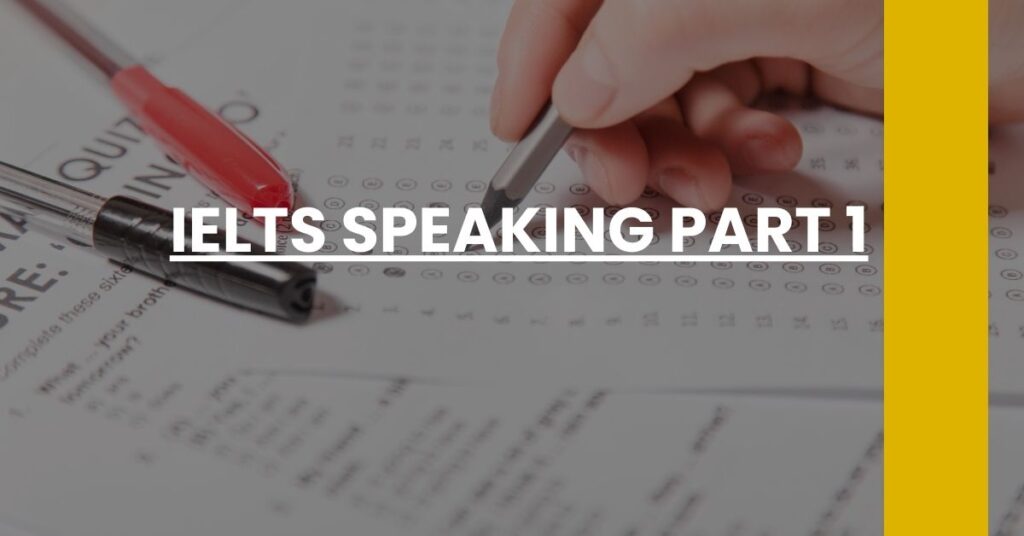IELTS Speaking Part 1 is your first step toward nailing the exam with confidence.
- IELTS Speaking Part 1 Structure: Understand the format and types of questions you’ll encounter.
- Effective Strategies: Learn techniques to maximize your speaking abilities.
- Common Topics: Familiarize yourself with subjects commonly discussed in this exam section.
Master IELTS Speaking Part 1 with these essential insights.
- Understanding IELTS Speaking Part 1: An Overview
- The Structure of IELTS Speaking Part 1
- Common Topics for IELTS Speaking Part 1
- Strategies to Approach IELTS Speaking Part 1
- Preparing for IELTS Speaking Part 1: Tips and Techniques
- Practice Makes Perfect: IELTS Part 1 Sample Questions and Answers
- Speaking with Confidence: Tips for a Fluent Interview
- Language and Vocabulary to Impress the Examiner
- Common Pitfalls to Avoid in IELTS Speaking Part 1
- Conclusion: The Path to IELTS Speaking Success
Understanding IELTS Speaking Part 1: An Overview
IELTS Speaking Part 1 is your initial opportunity to make a good impression on the examiner. During this initial interaction, you can expect a structured yet conversational session, where the examiner will assess your ability to communicate in English through a series of questions about familiar topics. Part 1 is designed to be a gentle warm-up, letting you speak on well-known subjects like your work, your studies, or your interests.
What to Expect in Terms of Format and Content
Typically, IELTS Speaking Part 1 lasts between four to five minutes, where you will answer general questions about yourself and your life. These queries won’t be challenging; they’re akin to what you might encounter in a friendly chat. However, don’t let the simplicity deceive you; your responses will showcase your fluency, vocabulary, and pronunciation – all crucial components for a high score.
The Structure of IELTS Speaking Part 1
Understanding the structure of IELTS Speaking Part 1 is imperative for a solid performance. This section is where you set the stage for a successful test by demonstrating controlled and coherent English communication skills.
Breaking Down the Components
You’ll be asked about three different subjects during this part. Initially, the conversation starts with an introduction, requiring you to answer simple questions about yourself. As the interview progresses, the examiner will cover two more themes, commonly centered around your daily life, hobbies, or preferences.
- Introductory Questions: These queries revolve around your name, place of residence, etc.
- Familiar Topics: Post-introductions, the discussion will explore topics like family, work, or hobbies.
- Transitioning Themes: The final set of questions will transition to another familiar topic, ensuring you have ample opportunity to demonstrate a range of vocabulary.
Common Topics for IELTS Speaking Part 1
In IELTS Speaking Part 1, the commonality of topics means you can predict, to a degree, the terrain you’ll be navigating. This foresight can immensely aid in your preparation – your answers should flow naturally, thoughtfully, and with an appropriate display of language proficiency.
Topics to Prepare For
- Hobbies and Interests: You should be ready to discuss your pastimes and why they appeal to you.
- Daily Routines: Be prepared to detail your everyday life and any particular habits.
- Work/Education Background: Expressing your study or work life in fluent English is a common request.
Strategies to Approach IELTS Speaking Part 1
Effective strategies will enhance your performance and potentially increase your IELTS Speaking Part 1 score. Remember that this is your chance to demonstrate comfort with the English language in an everyday context.
The Golden Rules
- Stay Relaxed: Speak as though you’re in a casual conversation, not an intense interview.
- Practice Responding to Various Topics: Anticipate likely subjects and prepare your thoughts.
- Conciseness and Clarity: While detailed, your answers should be straightforward and relevant.
Preparing for IELTS Speaking Part 1: Tips and Techniques
As crucial as knowing the structure of IELTS Speaking Part 1 is being fully prepared for it. Your responses provide a glimpse into your language skills, revealing how deeply you can engage with a topic in English. Let’s break down the essentials for a top-tier preparation.
Preparation Advice
- Understand the Assessment Criteria: Know what the examiners are looking for— fluency, coherence, and pronunciation are key.
- Simulate the Test Environment: Practice answering questions under timed conditions to build comfort and reduce anxiety.
- Fine-Tune your Vocabulary: Develop a strong base of words for common topics and learn to use them in context.
By embracing these insights into IELTS Speaking Part 1, you’re forging a path toward success. With careful preparation and a strategic approach, securing a high score in this section is well within your reach.
Practice Makes Perfect: IELTS Part 1 Sample Questions and Answers
Tailoring your practice to be as close to the real IELTS Speaking Part 1 experience is pivotal. Here we’ll provide you with a range of sample questions along with model answers designed to enrich your preparation regimen.
Sample Questions Emulating the Real Test
Imagine you’re sitting right across from the examiner, and they start off with:
- “Can you tell me about your hometown?”
- “What kind of job do you do?”
- “Why did you choose that particular career path?”
- “What subjects are you studying?”
- “Do you enjoy playing any sports?”
Crafting Your Answers
Consider these sample answers that demonstrate the breadth you should aim for:
- “My hometown is a vibrant city with a dynamic mix of the modern and the historical. It’s known for its rich culture and the warmth of its people.”
- “I work as an environmental scientist. Every day is an opportunity to learn and contribute to sustainability, which I find incredibly rewarding.”
- “The decision to pursue this career was driven by my passion for nature and a dream to aid in the global effort of preserving our planet’s ecosystems.”
- “Currently, I’m immersed in studying Computer Science because I’m fascinated by technology’s capacity to solve complex problems and its ever-evolving nature.”
- “I’ve always had an affinity for basketball. It’s a sport that requires both physical agility and strategic thinking, which I find exhilarating.”
Example Dialogue Simulation for Practice
Practicing with a Partner: Role-play with a friend to mimic the test environment. This can provide crucial feedback.
Recording Yourself: Consider recording your responses and playing them back to self-analyze and improve.
The goal in this section isn’t just to get the right answers; it’s about demonstrating fluency, coherence, and the correct use of language. Now, take the model responses and make them your own, echoing the natural way you would express these ideas authentically.
Speaking with Confidence: Tips for a Fluent Interview
When tackling IELTS Speaking Part 1, confidence is as important as competence. Below are strategies to empower you to deliver responses with poise and assurance.
Build a Routine for Fluency
Warm-Up: Start your study sessions with simple English conversations to get into the rhythm of speaking naturally.
Visualize Success: Use positive visualization techniques to build inner confidence before the test day.
Adopt a ‘Can Do’ Attitude: It’s easy to become overwhelmed but maintain a positive outlook and believe in your ability to succeed.
Embrace Correct Pronunciation and Intonation
Listen and Repeat: Engage with English media and practice mimicking the pronunciation and intonation.
Use Tools for Practice: Leverage language software and apps that provide instant feedback on pronunciation.
Speaking confidently requires practice and positivity. By incorporating these techniques into your preparation, you can enrich your speaking capabilities, ensuring a more fluent and self-assured delivery during IELTS Speaking Part 1.
Language and Vocabulary to Impress the Examiner
To leave a lasting, positive impression on the examiner, you’ll want to showcase your vocabulary range and appropriate language use.
Targeted Language Development
- Industry-specific Jargon: Showcase your depth of knowledge by using jargon related to your work or study field, appropriate to the topic.
- Descriptive Language: Employ adjectives and adverbs to paint vivid pictures and express yourself clearly.
Utilize Synonyms: Avoid repetition by having a good stock of synonyms that demonstrate the width of your vocabulary.
These language elements can elevate your performance, signifying to the examiner that you’re not just fluent but also have a command of rich and varied English vocabulary.
Common Pitfalls to Avoid in IELTS Speaking Part 1
Securing a stellar score in IELTS Speaking Part 1 is not just about doing the right things, but also about steering clear of common errors.
Missteps That Could Cost You Points
- Overthinking Responses: While it’s important to provide a full answer, don’t get caught up in trying to make your response overly complex or nuanced.
- Memorized Answers: Although preparing for common questions is essential, responses should feel spontaneous, not scripted.
- Speaking Too Fast: Pace yourself to allow for clear articulation and give the impression of a measured and considered response.
By avoiding these pitfalls and practicing thoughtfully, you’ll put yourself in a strong position to navigate IELTS Speaking Part 1 successfully.
Conclusion: The Path to IELTS Speaking Success
As you approach the IELTS Speaking Part 1, remember that this is more than an examination—it’s a conversation. This initial part of the test sets the tone for your speaking performance, so take it seriously, but also enjoy this chance to share about yourself. Equip yourself with the strategies and knowledge shared here, and you’ll pave the way toward an outstanding performance on test day.
Always bear in mind that preparation, practice, and presence of mind are your best assets. Combine these with the tips and techniques provided, and your journey to mastering IELTS Speaking Part 1 will not only be successful but also enjoyable.
Ace your IELTS Speaking Part 1 with proven strategies, expert tips, and practice exercises for a confident, high-scoring performance.

